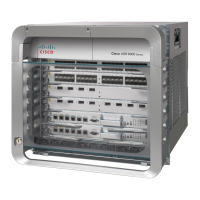167
Cisco ASR 9000 Series Aggregation Services Router Getting Started Guide
OL-28417-02
Chapter
R
RCP
remote copy protocol. A protocol that allows users to copy files to and from a file system residing on
a remote host or server on the network. The RCP protocol uses TCP to ensure the reliable delivery of
data.
RIB
Routing Information Base. This is the set of all available routes from which to choose the FIB. The RIB
essentially contains all routes available for selection. Essentially, it is the sum of all routes learned by
dynamic routing protocols, all directly attached networks (that is. networks to which a given router has
interfaces connected), and any additional configured routes, such as static routes.
RIP
Routing Information Protocol. A simple routing protocol that is part of the TCP/IP protocol suite and
the most common IGP in the Internet. RIP determines a route based on the smallest hop count between
source and destination. It is a distance vector protocol that broadcasts routing information to
neighboring routers. It is known to use excessive bandwidth. See also hop count and IGP.
ROM Monitor
ROM Monitor is a bootstrap program that initializes the hardware and boots the system when a router
is powered on or reset. ROM Monitor mode is also known as “ROMMON,” which reflects the CLI
prompts for the mode.
rommon B1> (ASR 9000 Router)
ROMMON
See ROM Monitor.
router
Network layer device that uses one or more routing metrics to determine the optimal path along which
network traffic should be forwarded. Routers forward packets from one network to another based on
network layer information.
routing
Process of finding a path to a destination host. Routing is very complex in large networks because of
the many potential intermediate destinations a packet might traverse before reaching its destination
host.
routing metric
A routing algorithm determines that one route is better than another. This information is stored in
routing tables. Metrics include bandwidth, communication cost, delay, hop count, load, MTU, path
cost, and reliability. Sometimes referred to simply as a metric. See also algorithm.
routing protocol
Protocol that accomplishes routing through the implementation of a specific routing algorithm.
Examples of routing protocols include BGP, OSPF, and IS-IS.
routing table
Table stored in a router or some other internetworking device that keeps track of routes to particular
network destinations and, in some cases, metrics associated with those routes.
RP
route processor. Cards that contain run-control software on the router. Two RPs are installed as a
redundant pair in dedicated slots in the front of each line card chassis.
RPF
Reverse Path Forwarding. Multicasting technique in which a multicast datagram is forwarded from all but
the receiving interface if the receiving interface is the one used to forward unicast datagrams to the source
of the multicast datagram.
RSVP
Resource Reservation Protocol. Protocol that supports the reservation of resources across an IP
network. Applications running on IP end systems can use RSVP to indicate to other nodes the nature
(bandwidth, jitter, maximum burst, and so on) of the packet streams they want to receive. RSVP
depends on IPv6. Also known as Resource Reservation Setup Protocol. See also IPv6.

